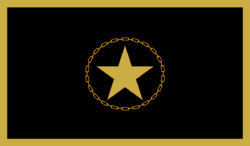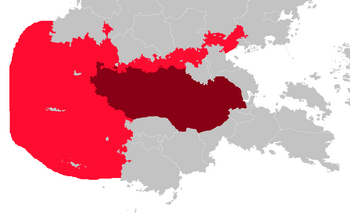Inner Sphere
Внатрешна сфера (Syaran) Daxili Sfera (Shirvani) | |
 Banner of the Inner Sphere | |
 Map of the Inner Sphere at it's greatest extent and influence. | |
| Formation | 1927 |
|---|---|
| Founder | Sasko Anastasov |
| Founded at | Zovahr |
| Dissolved | 1938 |
| Type | Military Alliance |
| Location | |
The Inner Sphere was a military alliance between the Republic of Syara and the Shirvani Dominion that initiated the Siduri War against Ruvelka and later the Common Axis. The ideological underpinnings of the Inner Sphere was mutual hostility towards the Cacertian Empire which had waged war against Syara and had incorporated Shirvaniya into its empire in 1875.
The Inner Sphere's origin lay in the aftermath of the Divide War between Syara and Cacerta; Syara's surprising victory in the conflict laid the ground work for an explosion of Syaran nationalism and industrial expansion. Syaran concerns over Cacertian desires for hegemony over Siduri led to the election of Sasko Anastasov, who desired to form an international power bloc to counter Cacertian influence. Despite efforts to rally the nations of Siduri, only the Shirvani Dominion under President Ceymur Agilli joined with owing to residual hostility towards Cacerta for its occupation of Shirvaniya from 1985-1922. The result was the formation of the Inner Sphere in 1927. Both Syara and the Dominion then underwent a rapid expansion of military might intended to challenge the Cacertian Empire, who at the time possessed the most powerful military in Tyran.
A major obstacle to the Inner Sphere was Ruvelka, which the Inner Sphere suspected for being under Cacertian influence owing to Cacertian support for the Imperial Separatist Movement of Ruvelka during the Ruvelkan Civil War. To both remove this threat from their borders and gain access to Ruvelka's mineral resources, the Inner Sphere invaded in April 1934, beginning the Siduri War. Hopes that the rapid military conquest would intimidate the other Siduri states into accepting Inner Sphere hegemony, the nations of Quenmin, Tennai, and Mansuriyyah instead formed an alliance with Cacerta, becoming the Common Axis. Assuming war was inevitable, the Inner Sphere launched simultaneous invasions of the three continental nations in October 1934.
Although initially at an advantage owing to their military buildup, the three-front conflict quickly devolved into a stalemate. By the end of 1935 the combined industrial and military might of the Common Axis began reversing Inner Sphere gains, while at sea the two sides clashed in long running campaigns in the Nuadan Ocean and the Sundering Sea. By 1936 the Inner Sphere had been forced into an arduous struggle along the Tennaiite Front, a war of long range maneuver in the Western Theater, while the Quenminese Front had become a bloody meatgrinder. Unable to achieve victory on land, the Inner Sphere attempted to defeat the Common Axis at sea, but was decisively defeated at the Battle of the Sabri Sea.
In 1937 the Common Axis invaded the Dominion, resulting in the death of Ceymur Agilli and causing the Dominion to switch sides. Syara withdrew back to occupied Ruvelka and attempted to forestall a Common Axis invasion, but was unable to prevent the Liberation of Ruvelka. With the collapse of the Armed Forces of the Syaran Republic imminent, Anastasov committed suicide on 16 January, 1938 and the Republic sued for peace. The resulting Treaty of Debrecen, signed on 10 February 1938, ended the war and dissolved the Inner Sphere.
Over the course of the war the Inner Sphere had mobilized 22,000,000 troops, suffering 8,500,000 killed, 1,000,000 missing, and more than 15,000,000 wounded and captured. The Inner Sphere committed various war crimes over the course of the Siduri War, sometimes against its own citizens, and was ultimately responsible for the deaths of over 25,000,000 people.